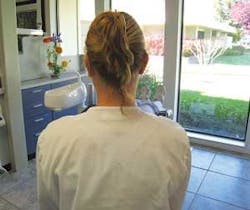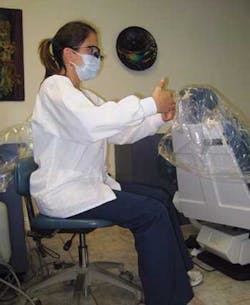Tai Chi and the RDH
Escape the demands of clinical practice.
I'd like to offer a unique perspective on ergonomics and repetitive strain injuries. I have learned that the principles and practice of qigong, tai chi and standing meditation have much in common with the practice of clinical dental hygiene. Preventing problems with body mechanics is one of the most fundamental and basic considerations facing today's clinical practitioner. Qigong, tai chi and standing meditation offer a fresh look and surprising complement to ergonomics.
I have been a dental hygienist for more than 30 years. I've survived both the physical and mental challenges of clinical practice. I attribute my freedom from problems with biomechanics to the mind/body concepts and classic principles of tai chi.
I was exposed to Chinese martial arts as a child. In my small rural community, our family shared a common alley with a grandmaster of kung fu. I listened as people spoke of the grandmaster and his secret. Students would come in hopes of learning this elusive chi (internal energy) from him, and I watched while he effortlessly bounced and threw his students. I knew this elderly Chinese man — this Kung Fu Grandmaster — as gentle and soft spoken, with an indescribable presence. Even now, I remember how intrigued I was with his inner calm and centeredness.
After I began my career in dental hygiene, I finally had the time to start on a path of self-discovery. One day I saw a group of people practicing tai chi in a park. This reminded me of a television special about China that showed a group of people in a park moving slowly and gracefully in unison, as if performing a dance. Compelled by my childhood memories of the kung fu grandmaster, I stopped to inquire about practicing.
From the day I started practicing tai chi, it felt familiar. Surprisingly, while practicing clinical dental hygiene one day, it came to me — the principles of tai chi are applicable to the practice of dental hygiene. A knowledge and practice of tai chi might help dental hygienists work effortlessly, manage the demands of ergonomics, and cope with internal and external stresses.
What Are Qigong, Tai Chiand Standing Meditation?
Qigong (also known by other spellings such as Chi Kung) translates as "energy work" or "energy exercise." Chi (Qi), pronounced chee, has several translations. It can mean energy, air, breath, or life. According to tai chi theory, it means "intrinsic energy," "internal energy," or "eternal and ultimate energy." Qigong encompasses many types of energy work, including tai chi and Zhan Zhuang (also known as standing meditation). Aspects of the practice of qigong include:
- Body mechanics and posture
- Integrated movement
- Rhythmical breathing
- Meditation and a state of mind
Tai Chi (pronounced tie chee) is sometimes referred to as moving meditation. Of the many systems of qigong, tai chi is the most familiar to Westerners. Tai chi originated in ancient China as a martial arts form called Tai Chi Chuan and has evolved as a mind/body practice. Tai chi combines intense mental focus with deliberate, graceful movements that improve strength, agility, and balance. Tai chi involves a greater degree of movement than yoga. Unlike many aerobic exercises such as running, there is no jarring motion that impacts the joints and spine.
Standing meditation (Zhan Zhuang) is a series of postures and stances designed to develop, unify, and direct chi. Though traditionally practiced while standing in an upright position, standing meditation can easily be adapted to a seating position. The poses of "seated meditation" are what I discovered resembled the correct ergonomic posture of clinical dental hygiene.
Tai chi is most commonly practiced to ease stress and as a gentle workout. New research suggests that this ancient Chinese practice has a multitude of health benefits.
In a study at the University of California, Los Angeles, older adults who practiced tai chi bolstered their immunity and diminished infection from the painful shingles virus. "With its slow, soothing movements, tai chi can lessen the activity of hormones known to suppress immunity," said Dr. Michael Irwin, the author of the study. "Tai chi's calming effect on the nervous system and ability to increase T-cells may help protect against viruses besides shingles."
"The effect could be synergistic: exercise in general seems to boost immunity, but tai chi combines mind/body work, exercise, and group practice in a way that has the potential to be especially good for the immune system," says Peter Wayne, PhD, director of tai chi research programs at Harvard Medical School's Osher Institute.
The National Center for Complementary and Alternative Medicine at NIH (National Institute of Health) refers to meditation, tai chi, and qigong as "mind-body medicine." One Boston Public Middle School established a five-week program that demonstrated the mindfulness-based stress reduction attributed to the practice of tai chi. A summary of the students' statements suggests that they "experienced well-being, calmness, relaxation, improved sleep, less reactivity, increased self-care, self-awareness, and a sense of interconnection or interdependence with nature."
"Tai chi is clearly an exercise program, but it has something more," states Andrew Monjan, chief of the National Institute on Aging's neurobiology of aging branch. "It seems to be somewhat more effective than simple exercise and more effective than simple stress reduction. It looks like a strong phenomenon, a fairly robust effect. Tai chi's combination of slow, steady movements, rhythmic breathing, and meditation appear to offer a unique mix of benefits. It builds aerobic conditioning."
In October 2007, The University of California Davis Medical Center assessed the effectiveness of tai chi, yoga, meditation, and Reiki healing sessions in promoting health and enhancing problem-solving abilities of registered nurses. Given the current necessity of retaining qualified nurses, a self-care program incorporating these disciplines was designed for the university-based hospital.
The effectiveness of these interventions was evaluated. The outcomes of the self-care classes described by the nurses included:
- Sensations of warmth, tingling, and pulsation, which were relaxing
- An enhanced problem-solving ability
- An increased ability to focus on patient needs.
The most significant conclusion of the study was that "hospitals willing to invest in self-care options for nurses can anticipate patient- and work-related benefits."
Qigong Complements Clinical Dental Hygiene
There are many resources and products that address the issue of ergonomics and repetitive strain injuries for the clinical dental hygienist. Peruse the many publications you currently receive to find new and modified designs, special instruments, magnifying loupes, ultrasonics, and operator chairs with arm rests. Many of these products may help minimize musculoskeletal disorders of clinical practice. Additionally, you may want to incorporate qigong, tai chi, and standing meditation as a preventive step. Qigong can be a "whole system" of psycho-physiological or mind/body integration.
Body Mechanics and Posture
The slow and fluid movements of tai chi improve posture, body alignment, strength, stamina, balance, flexibility, and coordination. While assessing one's posture to practice qigong, tai chi and standing meditation, the practitioner reviews the posture from the head to the feet. Some of the tai chi principles relevant to dental hygiene are:
- Central equilibrium entails the top of the head in vertical alignment with the spine
- The head/neck is stretched slightly upward with a slight tuck of the chin
- The shoulders are relaxed with the back rounded about 15 degrees forward and arms stretched outward in front as if holding two balls
- Wrists are held neutral (neither flexed nor extended)
- The lower back is positioned so that the pelvis is rotated forward, stretching the lower or lumbar spine so the individual vertebrae are open slightly
- Both feet are firmly planted on the ground to maintain stability, alignment, and balance
To practice standing meditation, note the ergonomic consideration and importance of body mechanics. The postures and alignment of the back, neck, arms, wrists, and shoulders are the same, whether practicing standing meditation to relax, or practicing "seated meditation" as a dental hygienist.
Integrated Movement
The concept of integrated movement is critical to clinical practice. Integrated movement refers to body movement as a single unit. Tai chi principles create the ideal framework and structure for operator efficiency, thereby avoiding injury. Examples of tai chi principles applied to clinical dental hygiene practice include:
• Keeping a stable fulcrum. The use of the fulcrum is applying the "rooting" concept in tai chi. Rooting helps integrate the clinician's stroke and aids in removing tenacious deposit more easily.
• Maintaining a neutral wrist and grasp of the instrument. Hand and arm then move as one unit, thus avoiding injuries related to repetitive strain. When the wrist is neutral, it is neither hyper-extended nor hyper-flexed. Fingers, hand, wrist, and arm are then able to function as one unit. An additional benefit is that less force is needed to do the same work.
• Neutral, relaxed, and upright neck and shoulders posture that minimizes upper body tension while practicing central equilibrium and alignment. Central equilibrium, starting with the head, neck, and shoulders in alignment, and extending down the back to the lower spine, creates a neutral posture. In turn, a better-aligned spine allows for the improved musculoskeletal support necessary for clinical practice.
• Having the head, neck, shoulders, and back in upright alignment. This facilitates a relaxed, neutral position while working and allows one's chi to flow freely and thus create balance. A clinician that utilizes the full clock position to access the patient also helps maintain an integrated posture.
• Keeping the height of the operator chair seat low enough to maintain neutral posture and straighten the lower back. Straightening the lower back opens the vertebrae and allows the chi to flow without obstruction.
• Keeping both feet firmly planted on the floor. With the chair at a proper height and feet positioned on the floor, the body is in central equilibrium, grounded and more stable. This tai chi principle helps maintain balance and strength.
Rhythmical Breathing
Focused, deep, and rhythmical breathing relaxes the body's response to stress, oxygenates the blood, and increases circulation of blood to the body, muscles, and brain. The breath, which is essential for life, is both energizing and relaxing. It facilitates a rejuvenating effect and allows the practitioner to be more present and conscious. The benefit to the clinical dental hygienist is to better manage the demands of the workday and patients.
Meditation and State of Mind
To the casual observer, Qigong, Tai Chi and Standing Meditation appear to calm. But it is the internal experience and personal clarity that may be difficult to attain, yet are so valuable.
Getting Started Is Easy
- No special equipment or gear is needed
- Practice can be anywhere and anytime
- Very little space is needed
- Clothes are loose fitting and comfortable
When thinking about learning qigong, tai chi and standing meditation, consider practicing with a teacher. Learning from a teacher (vs. videos or books) allows a student to discover the subtleties of the movements and whether they are performed correctly and safely. Be patient. Remember that qigong is unlike anything you're familiar with. Learning is a gradual process and takes time. It is the proper practice … doing it right … that cultivates chi and achieves the optimum results. Being able to direct one's chi is the ultimate goal for health.
About the Author
Carol Lee, RDH, BS, received her degree in dental hygiene from the University of California San Francisco and has been in clinical practice for more than 30 years. She is also Adjunct Faculty of the Sacramento City College Dental Hygiene Program. She has held numerous state and local component positions in the California Dental Hygienists' Association (CDHA), including CDHA President. Carol has received several local and national awards for her community outreach efforts, including the ADHA Colgate Community Outreach Award. Under her leadership and guidance as CDHA Vice President, Carol sparked the development of the CDHA Web site, which was one of the first in the nation. Carol was honored nationally with the Sunstar/RDH Magazine 2007 GUM Healthy Life/RDH Award of Distinction.




